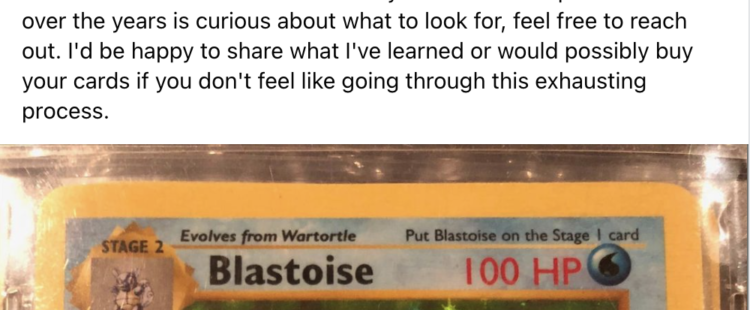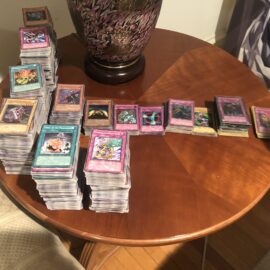Disclosure: I may earn affiliate revenue or commissions if you purchase products from links on my website. The prospect of compensation does not influence what I write about or how my posts are structured. The vast majority of articles on my website do not contain any affiliate links.
In the middle of 2020, I found myself spending the summer with my parents in Scranton. Almost all of my friends had long since moved away. Increasingly obscure avenues helped me pass the time. One of my hobbies was playing old Adobe Flash games. This culminated in my long-form article on the Sinjid Trilogy later that year. For the most part, life moved at a much slower pace and I was less goal-oriented. I appreciated the time with my family and I couldn’t help but reminisce on my childhood.
Over the years, I’d been keeping tabs on the Pokemon and Yu-Gi-Oh! markets. Every once in a while, there’d be an article about some insane sale of a late-nineties or early-2000s trading card. I had a pretty good idea of where I stood but I never had an interest in pursuing things further. I didn’t have much of a concept of personal finance in high school. In college it seemed like a terrible way to spend a break away from school.
Then the Logan Paul pump occurred.
Not only were the values of the high-end cards becoming well-disseminated (“Logic spent $250k on a PSA 10 Charizard!”) but nineties kids were also rushing to rip through their childhood collections and send the cards off to PSA. That’s the Professional Sports Authenticator, relatively equivalent with Becket as the most prestigious and trusted group of collectible authenticators. I decided it was time to dig up my cards and send them away.
Grading & Authentication
To standardize cards as investments, collectors trust major grading services to authenticate and grade the condition of the cards. If you visited card shops as a kid, it’s likely that you encountered at least a few rare cards in plastic slabs. These were incredibly expensive relative to other wares in the store, and it’s safe to say that I had no business with these cards. Plus, the slab took away the fun part–you couldn’t play the actual card games using the slabs!
The PSA rating system is ubiquitous. The numbers range from 1 to 10. There is a lot more than meets the eye here. At first, I figured that any cards that seemed visually perfect would be PSA 8s. This was not the case. As I later learned, a card handled carefully straight out of the pack might only be a 9/10. This is mainly due to the centering of the graphic on the card stock. This centering, on the older and more valuable cards, had a much wider margin of error than in later printings.
There are so many nuances to grading. There are two approaches you can take: leave it to the experts 100% or try to become an expert. Since my original plan was to buy the collection from every single person I knew in my hometown, I decided on the latter. Plus, I needed to know what cards to even send away to get graded. I can say that I became very good at assessing cards, as my own grading spreadsheet tracked quite close to the pre-grades I received. However, I was far from perfect, and, believe me, this is a tiring activity.
The authentication process is harrowing and pretty expensive. I used Ludkins, which is widely considered the #1 PSA grading service. Why do you need a grading service for your grading service? It seems a bit inefficient to me, but Ludkins has experts who will provide verbal, unofficial grades for cards significantly more quickly and less expensively than the people at PSA. So you can ask Ludkins to “pre-grade” your cards and then only send the excellent ones on to PSA. You also get access to their special bulk tiers of pricing. I can’t say it was a no-brainer since it’s such a leap of faith to send one’s entire childhood to a corporate mailbox in Virginia, but that’s what I did.
Assessing Your Collection
This is the part that most people will gloss over. It cannot be ignored. If you’re out of college and you’re a working professional, your time probably has value on an hourly basis. Not even to be a college-degreed elitist, plumbers’ time is valuable, too. Now, some people have basically no marketable skills and so their time is roughly–roughly–equivalent to minimum wage. There’s a wide spectrum! But even if you have a small stack of cards and you know where they are, this is not an hourlong process. Not even close.
There is so much to research required here that most people will grow bored with the activity quickly. After I put in the work myself, I hoped that I could take advantage of this and relieve some of my Facebook friends of their collections at a fair price. However, greed was rife with literally all of these people, so any of my offers to buy out collections were rebuffed. I had some people rebuff my offers just to spend even more time driving around to card shops just to sell at… wait for it… the exact price that I had offered them a week later. Just total madness.
So, what part of this takes so much time?
You have to take inventory of your entire collection, then check to see which of those cards are valuable. Then, finally, pack a few cards properly and send them away. If you last collected Pokemon cards when you were 6, 7, or 8 years old, you’ll have a lot of fond memories, but little knowledge regarding what cards are sought after or what the difference between a PSA 7 and a PSA 10 is.
More so now than in mid-2020, my time is valuable. Not only to other people, who are willing to pay me cash money, but also the time I spend personally. I’ve grown to appreciate how wonderful it is to have ownership over my time to pursue hobbies and build relationships. In the assessment stage of this endeavor, I reviewed just under 3000 cards (between YGO! and Pokemon), catalogued 200, and ultimately sent away about 70 to be graded. Including time spent researching grading companies and corresponding with them, this phase took me roughly 40 hours.
It took me roughly 40 hours of work before I was comfortable moving forward.
Why? What was the Upside?
There were several factors that motivated me to move forward with getting my collection graded.
- To preserve what were relics of a happy childhood and recapture some of those memories
- To increase the value of my collection and make the cards easier to sell and trade
- To become knowledgeable about cards and collectibles in general
- To fuel a foray into YouTube content creation
I don’t have to get too sappy on point one. I think it’s fair to say that if you still have your Pokemon cards, you probably had a happy childhood. I personally never learned how to play the game and also the internet was in its infancy, but I spent hours upon hours flipping through my binder and reviewing the cards with my grandmother as a kid. How about those times where we pulled rare cards from the booster packs? These were priceless memories.
Kids in my neighborhood graduated from Pokemon to Yu-Gi-Oh right around 3rd and 4th grade. That was around ages 8/9. Yu-Gi-Oh was quite popular maybe even through 2006 (age 11 or 12). Then, everyone graduated to video games. I cannot tell you how much fun we had playing YGO, between tournaments at my house and everything else that came with collecting. Where Pokemon came alive through the Gameboy games, Yu-Gi-Oh! was a fun, well-thought-out card game. Unfortunately the slight improvement curve as the franchise matured meant friends who didn’t have as much money to buy new cards would get walloped in later matches.
The main judgment, really, was to increase the value of my cards and allow them to be treated like commodities. This came at an upfront cost of roughly $15 per card. All-in, it cost me almost $1000 to get 70 cards graded. That’s a lot of money! The reasonable question is: did that investment pay off in direct increases to the card values? Based on the pricing I reviewed for most cards, it seemed that a PSA 7 slab would generally sell at more than a $15 premium over the loose card that appeared to be in PSA 7+ shape. This isn’t always true and required a bit of a leap of faith on my end. For example, some common cards like black star promos probably aren’t really worth anything as PSA 6 or 7s. There’s not much of a market, and I might spend months trying to sell some of these cards.
The grading boosts that mattered (loose card versus graded version) definitely gapped my direct cost to get the cards graded, but, as of the time of writing this, came nowhere near to the value of my time spent on this endeavor.
All this time spent, though, did cause me to become very knowledgeable and confident in valuing typical Pokemon and YGO cards from this era. I hoped to parlay this into many good deals but, as of the time of writing, I only made one deal, it was on eBay. It did go in my favor, but I was really, truly looking forward to building my collection significantly and preserving the cards better than most of the people from my hometown.
To the final point, I did start making Pokemon-themed YouTube videos. These were taking too much time, I didn’t have much of an audience, and after making a few I decided to keep focusing on writing (which really worked out for me in 2021!). It was also difficult to continue making videos about trading cards because …
What Happened?
Many people don’t realize this but there were a few significant events after the first few months of hype and hysteria. First of all, PSA and most other grading services, either suspended grading of new cards or seriously restricted their service tiers. Soon after my cards were sent to PSA, they stopped grading cards on the low tiers and only accepted cards submitted at much-higher-priced tiers, costing several multiples of what I paid. Next, as people (very gradually) received their cards back, there was a genuine supply increase across the board. There were more “box breaks,” additional very-old packs were opened, more cards were graded. Supply increased.
Most of these people were looking to cash out. As a result, the market tanked, and quite significantly. Wait–how long did I have to hold out to receive my graded cards?
It took roughly 9 months for all of my cards to be graded and returned to me
In the time it took for me to receive my cards (I was actually out of town when they arrived so it took a bit longer), the market changed a lot. I didn’t have the heart or interest to follow it regularly. Looking up prices, it was plain to see that there had been a major correction. I didn’t intend to sell my cards immediately but it was a bummer. Having to wait almost a full year before I could feature my cards in video content took away all the enjoyment for me.
Also, I will say that one of my cards arrived with the slab damaged (Ludkins was willing to put it back in the process, though they made me pay for shipping), so that part of this story is ongoing.
My Most Valuable Card
My shadowless 1st-edition Blastoise received a PSA 7. All things considered (this was my oldest card), a PSA 7 is incredible. Since I had no other shadowless 1st edition cards, I must have obtained this as a single, likely from a card shop. It looks as if it was never removed from the binder since first being placed in it. It’s a rare card that doesn’t change hands very often. There are still a few hundred of them. And, believe me, that number has increased by over 10% since the Pokemon craze was re-ignited.
Second to that, I’d have to check, but I probably have a few cards in the hundreds-of-dollars range from the Southern Islands set.
Yu-Gi-Oh! Versus Pokemon
Mid-way through writing this section, I decided to dedicate a separate blog post to my YGO cards in which I could give a brief explanation of each of the nine cards I sent our. You can check that out here.
What Do I Do Now?
Of all the little tangents of my adult life, this had to be the most anticlimactic. I put in a ton of initial work and spent nearly $1000 just to wait around for almost an entire year. Worse, the market lost its mojo, and all of the people in my network who I was hoping to buy the collections of have surely moved on. I’m back to where I started, with a Pokemon collection that is probably still the envy of my friend group. My grandmother still enjoys reviewing the cards with me.



